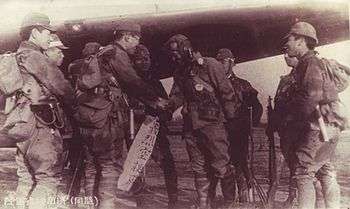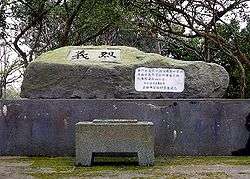Giretsu Kuteitai
Giretsu (義烈空挺隊, Giretsu Kūteitai) ("Heroic Paratroopers") was an airlifted special forces unit of the Imperial Japanese Army formed from Army paratroopers, in November 1944 as a last-ditch attempt to reduce and delay Allied bombing raids on the Japanese home islands. The Giretsu Special Forces unit was commanded by Lieutenant General Michio Sugahara.
| Giretsu (義烈空挺隊, Giretsu Kūteitai) | |
|---|---|
 Captain Okuyama and Giretsu Airborne unit depart on their mission to Okinawa | |
| Country | Imperial Japan |
| Branch | Imperial Japanese Army |
| Type | Special forces/airborne |
| Engagements | Pacific War |
| Commanders | |
| Notable commanders | Lieutenant General Michio Sugahara |
History
After USAAF B-29 Superfortress strategic bombers began attacks on Tokyo from bases in the Mariana Islands, the 1st Raiding Brigade of the Teishin Shudan was ordered to form a commando unit for a “special operations” mission to attack and destroy the bombers on the Aslito Airfield on Saipan. Captain Michiro Okuyama, commander of the Brigade's engineering company and trained in sabotage and demolition was selected as mission leader, and he selected an additional 126 men from his own team (1st Teishin-Dan 1st Regiment 4th Company) to form the first Giretsu Airborne Unit. It was initially organized with a command section and five platoons and one independent squad, based at the IJA air academy at Saitama. The group unit also included eight intelligence officers and two radio men from the Nakano School.
Tactics
The Giretsu operations were to be undertaken at night, beginning with air strikes by bombers. After this, commando units would be inserted onto the target airfield by crash landing their transports. The fact that there was no provision for extraction of the strike force, along with the rejection of surrender in Japanese military doctrine at the time, meant that the Giretsu ground operations were effectively suicide attacks.
Operations
The attack against the Marianas was scheduled for 24 December 1944, but was called off after American raids damaged the planned refueling airfields on Iwo Jima. After the Marianas raid was cancelled plans were made to attack airfields on Iwo Jima captured by the United States Marine Corps in March, but these too were cancelled when the Iwo Jima garrison fell.
On 1 April, US forces landed on Okinawa, and American fighters based on Okinawa's west coast intercepted and shot down many kamikaze aircraft attacking the American fleet. In the middle of April, the Sixth Air Army requested the deployment of the Giretsu Special Forces to neutralize these airfields, in what was designated "Operation Gi-gou". On 18 May, this was authorized.

On the night of 24 May 1945, 12 Ki-21-IIbs of the Daisan Dokuritsu Hikōtai ("3rd Independent Squadron": 32 crew members commanded by Captain Chuichi Suwabe) were dispatched for a strike, each with 14 commandos. Eight were assigned to attack Yontan and four to Kadena. Four aircraft aborted the mission with engine problems, and three more were shot down, however five managed to crash-land at Yontan Airfield during the confusion caused by a diversionary attack by some 50 IJAAF and IJN bombers and fighters.

Only one plane landed successfully. About 10 surviving raiders, armed with submachine guns and various explosives then wreaked havoc on the supplies and nearby aircraft, killed two US servicemen, destroyed 70,000 gallons of fuel and nine aircraft, and damaged 29 more before being nearly annihilated by the defenders. One member of the raiding party survived and was able to make his way across the battlefield reaching the Thirty-Second Army Headquarters (Okinawa) around 12 June.[1]
A second large-scale attack on bases in the Marianas with the specific intent of destroying B-29 Superfortress bombers was again planned with 60 transports and 900 commandos for the nights of 19–23 August 1945 (Operation Ken-gou). On 15 August, Japan surrendered and the operation was canceled.
Uniforms and equipment
Giretsu personnel wore special hand-made camouflage uniforms and carried special equipment. Most were armed with Type 100 submachine guns, Type 99 rifles, Type 99 light machine guns, and Type 30 bayonets, Type 89 Grenade Dischargers, Type 99 Grenades and Type 99 mines, as well as Type 94 8 mm Pistols.[2]
See also
Notes
- "Sixth Air Army Action Report" IJN Confidential Telegram No.121340 ,12 June 1945
- Giretsu Kuteitai Attack Plan, Equipment list
References
- Gakken (2005). Okinawa Kessen(means,The Decisive Battle For Okinawa). Gakken. ISBN 4-05-603892-9.
- Hata, Ikuhiko (1986). Dainiji Taisen Koku Shiwa(means,Aviation Tales of World War II), Volume 3. kofusha-shuppan. ISBN 4-87519-744-6.
- Imperial Japanese Army, Giretsu Kuteitai (1945). Giretsu Kuteitai Kougeki Keikaku(means,Giretsu Kuteitai Attack Plan).
- Imperial Japanese Navy (1945). Nansei Shoto Dempo Tsuzuri(means,Telegram Files of Southwest Islands).
- Japan News Record Committee (1980). Gekido no Showa (means,Turbulent Showa-era). Japan Broadcast Publishing.
- Jowett, Philip (2002). The Japanese Army 1931-1945, Volume 2. Osprey. ISBN 1-84176-354-3.
- Ministry of Defense Japan (1968). Senshi Sosho Volume 11: Okinawa Houmen Rikugun Sakusen(means,Okinawa Area Army Operation). Asagumo Shimbunsha.
- Ministry of Defense Japan (1970). Senshi Sosho Volume 36: Rikugun Koku Sakusen(means,Army Air Operation),Okinawa etc. Asagumo Shimbunsha.
- Nakanishi, Ritta (1991). Japanese Military Uniform 1930-1945. Dai Nippon Kaiga. ISBN 4-499-20587-5.
- Rottman, Gordon (2005). Japanese Paratroop Forces of World War II (Elite). Osprey. ISBN 1-84176-903-7.
- Tanaka, Kenichi (1972). Aa Junpaku no Hana Oite(means,Shouldering Pure White Flower). Gakuyo-shobo.
- Tanaka, Kenichi (1976). Kaeranu Kuteibutai(means,The Airborne Unit Doesn't Return). Hara-shobo.
- Tv Tokyo (1985). Shogen Watashi no Showa-shi(means,The Testimonies : My Showa-era) Volume 5. Obunsya. ISBN 4-01-064305-6.
- U.S.Army (2005). Okinawa: The Last Battle. University Press of the Pacific. ISBN 1-4102-2206-3.
- Yomitan Village (2003). Yomitanson-shi(means,The History of Yomitan Village) Volume 5.
External links
- Time Magazine (4 June 1945). "June 4, 1945". Retrieved 3 May 2010.
- Naval History Magazine (June 2010). "The Giretsu Attack". Retrieved 6 May 2010.
- Nippon News, No. 252. in the official website of NHK."Giretsu Kuteibutai".